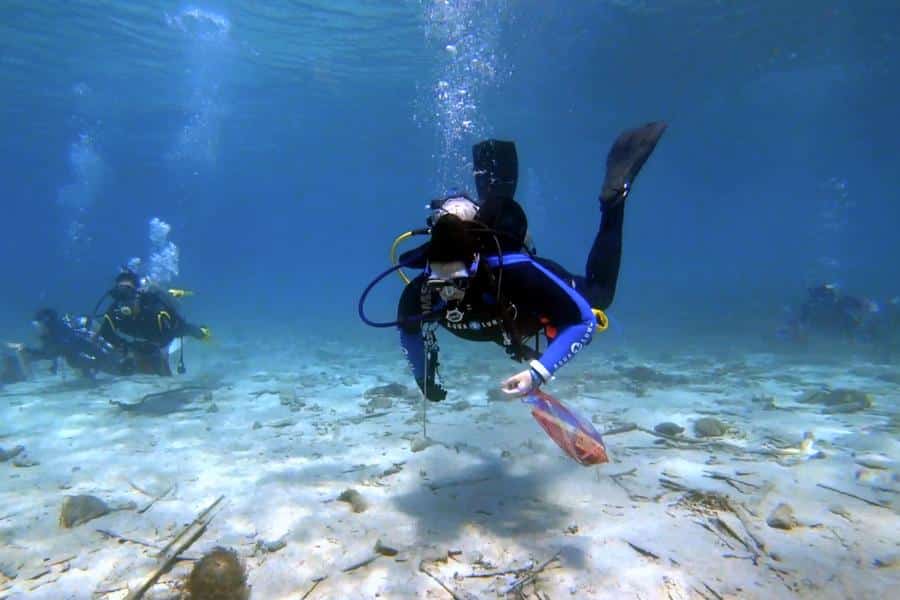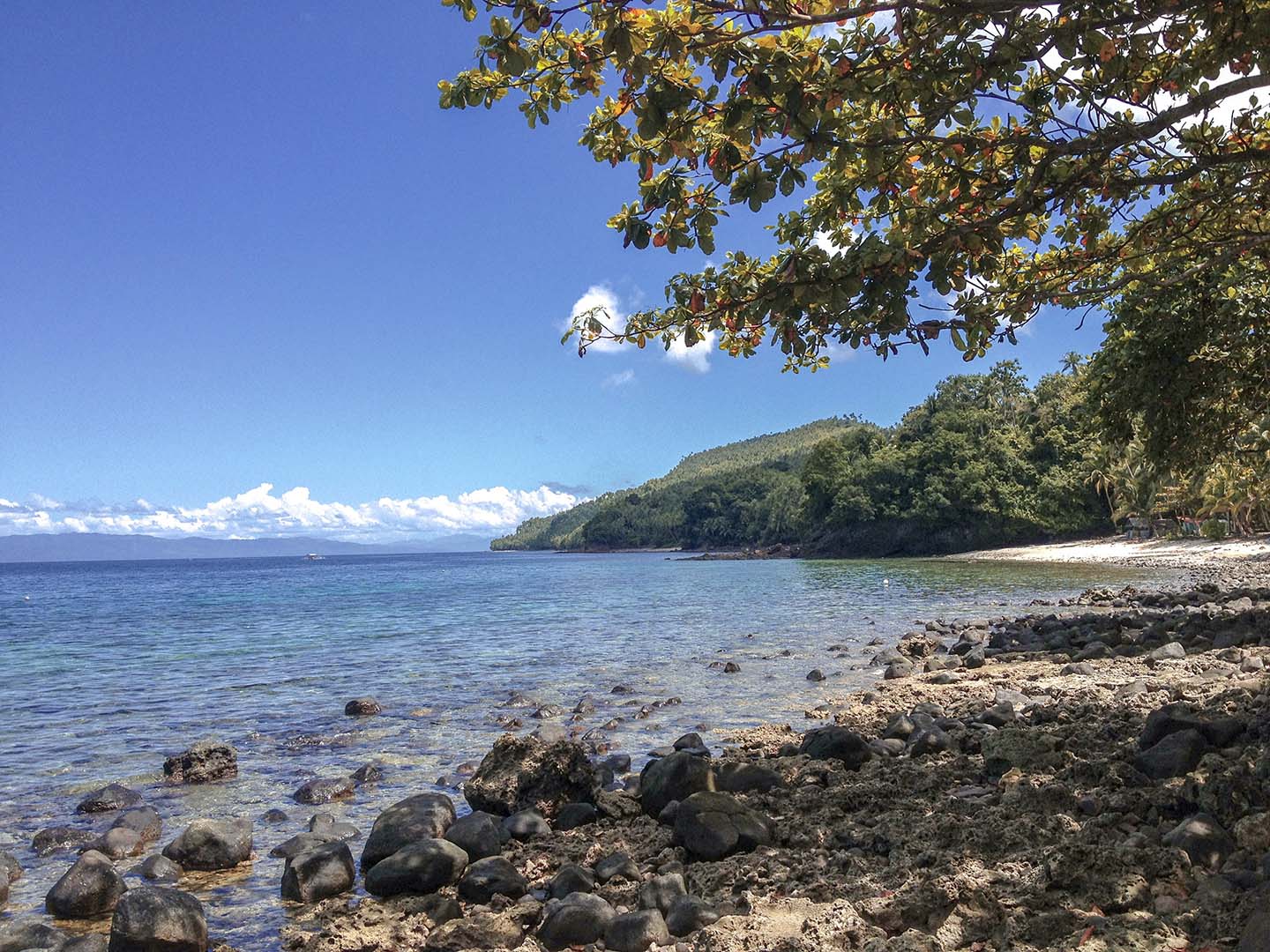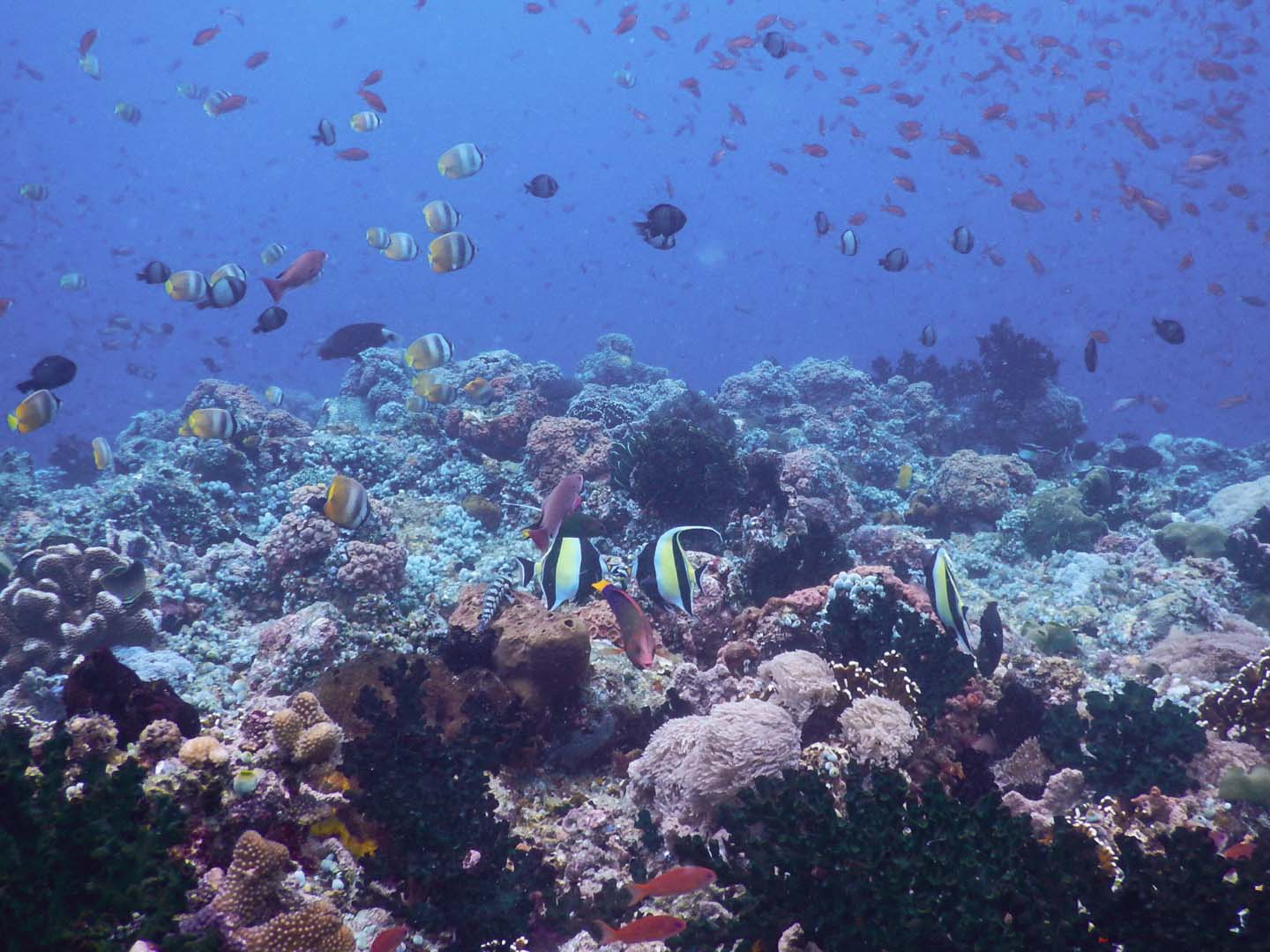I am no stranger to underwater cleanup dives. Every year I participate in at least one event where we scuba dive for the purpose of removing trash in the ocean. I’ve done beach dive cleanups during PADI Women’s Dive Day and International Coastal Cleanup Day.
With World Oceans Day just around the corner and with all these cleanup events I’ve been seeing lately, I decided to share with you some underwater cleanup tips for scuba divers.
These cleanup diving tips are based on the different ocean conservation dives I’ve done in the past. Aside from participating in cleanup events, my volunteer experience in Coral Cay Conservation and Marine Conservation Philippines has taught me a thing or two when it comes to being an eco-diver.
I know many scuba divers are eager to help and do their part in saving the ocean. Which is great!
But sometimes, despite our good intentions, we could actually be doing more harm than good.
I know I am guilty of this simply because I just didn’t know any better. I admit that I may have done some things that I probably shouldn’t have done during an underwater cleanup. To be fair, at the time, I thought I was doing the right thing. It was only later on that I learned that I wasn’t, which prompted me to change my ways.
While there are briefings on these dive cleanup events, I noticed that they are not as thorough. In this post, I’ve written down everything I’ve learned so far about being a more eco-conscious scuba diver.
Whether it’s your first time helping clean the ocean or your 5th dive cleanup event, this will remind you of what to do and what not to do, to have the safest and most eco-friendly dive.
- 1. Familiarize yourself with the dive site
- 2. Dive with a buddy
- 3. Maintain good neutral buoyancy at all times
- 4. Watch your fins
- 5. Avoid dragging anything
- 6. Use protective gear and appropriate tools
- 7. Work slowly and carefully
- 8. Watch out for dangerous marine creatures
- 9. Be selective
- 10. Know when to leave things alone
- 11. Use a lift bag to remove heavy objects
- 12. Go through the trash collected and check for marine animals
- 13. Do a trash audit
- 14. Properly dispose of the trash
- 15. Share on social media to create awareness
- Making a difference beyond the cleanup dive.
1. Familiarize yourself with the dive site
For underwater cleanup events, it is most likely that the organizers have selected a site for you to focus on. Prior to the dive learn as much as you can about the marine environment of the area.
Attend the orientation and dive briefings. Don’t be afraid to ask questions.
What are the dangerous animals you might encounter? Perhaps it’s Titan triggerfish nesting season and you need to keep an eye on them. Or maybe you need to watch out for stingrays that may be hiding in the sand.
What kind of marine debris are you most likely to find? Will there be lots of glass, cans, and sharp objects? Or maybe there will be lots of fishing nets. Knowing this will help you decide on what tools to bring underwater.
Is it suitable to dive in at this moment? Heavy swells or current might bring in the trash but it also makes it difficult to gather underwater. Make sure that the dive site has minimal current at the time of your cleanup. Also, assess how easy it is to enter and exit the water because remember you will be hauling trash with you.
If at any time the dive conditions and environment are not suitable for you, remember that it’s okay to sit one out or do just do a cleanup another time.
2. Dive with a buddy
Always dive with a buddy while doing a cleanup dive. You have to treat the cleanup dive like any other dive where things can go wrong.
You can have a dive emergency. Your equipment could malfunction. A marine animal could sting you. You can get cut or hurt as you remove marine debris. A dive buddy can help you in these situations.
Before you enter the water, don’t forget to do your buddy check and assign roles or tasks roles or tasks for the cleanup.
Will you be in charge of picking up the trash while the other holds the mesh bag? Or will both of you have trash bags? Does either of you have the right tools to get the job done?
It is also safer to remove marine debris with the help of someone rather than doing it on your own. In some cases, you might even have to work as a trio and that’s okay too.
3. Maintain good neutral buoyancy at all times
If you’re new to diving and you’re still struggling with your buoyancy, I would recommend you work on your buoyancy first before joining a cleanup dive.
During these ocean cleanup activities, you will need to put yourself close to the reef to remove the marine debris. If your buoyancy control is not on point, you might crash into coral or disturb the sand where many critters live.
You will also be taking additional weight each time you pick up marine trash so you should know how to compensate for this excess baggage.
So, master your buoyancy skills first before taking on an additional task like collecting trash underwater. Don’t let your poor scuba diving skills bring more harm than good to the marine environment.
You can take additional dive courses like the Peak Performance Buoyancy, if this is a skill that you need to work on.
4. Watch your fins
During a cleanup dive, you might get too focused on collecting rubbish that you don’t notice that you’re stirring up the sand behind you or you’re hitting a coral with your fins. Always be aware of where your fins are.
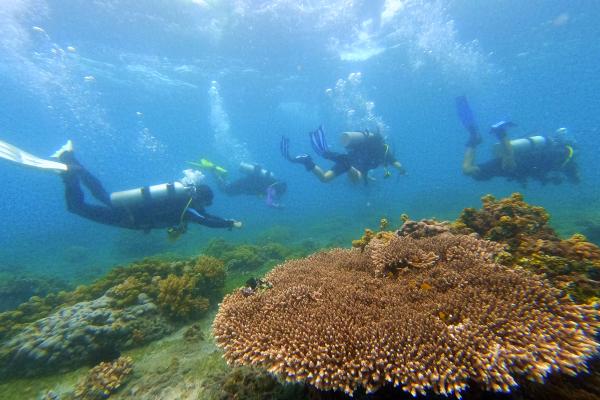
Avoid doing flutter kicks as you swim over sandy areas or coral reefs. Do frog kicks instead as these are more efficient in propelling you forward without disturbing the surrounding environment.
If you are a more advanced diver, you can also practice doing backward fin kicks or helicopter fin kicks to easily maneuver in tight spaces. Proper finning techniques can lessen your impact on the reef.
5. Avoid dragging anything
One of my diving pet peeves is when divers allow their scuba equipment to dangle and drag through the sand and coral.
Make sure that your alternate air source or octo, air gauge, straps, and lanyards are tucked in and fully secured. Keep a safe distance from the reef at all times to avoid damage.
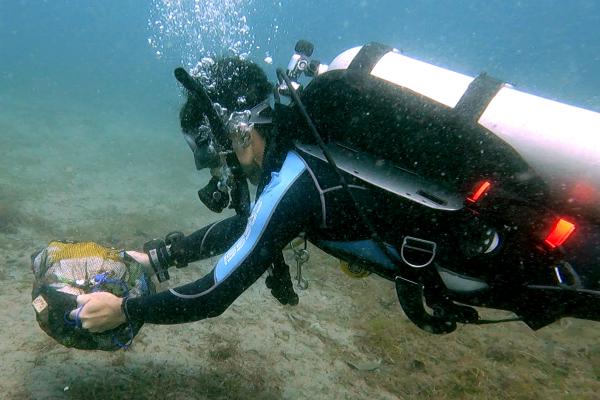
Do not clip your trash bag to your BCD. Instead, hold it with your hands. This is to avoid hitting the reef and also for your safety. In case of an emergency, you should be able to ditch the bag easily.
6. Use protective gear and appropriate tools
Wear gloves so you avoid touching anything with your bare hands. This gives you a bit of protection from dangerous animals as well as from marine debris that could scratch or cut you.
In my experience, it is best to bring your own cleanup gloves because usually cleanup event organizers do not provide this.
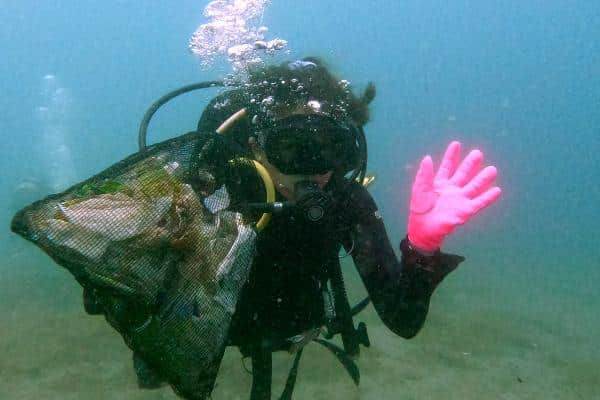
You can also bring metal tongs which you can use to get trash from hard-to-reach areas. But more importantly, so you’re not touching the marine debris with your hands.
Bring durable shears, dive knife, or fishing line cutters. It is very common to find nets or ropes entangled on the coral reef.
A mesh bag with a sealable top works best when you’re collecting trash underwater.
7. Work slowly and carefully
An underwater cleanup is not a race and should be done in leisure. Move slowly and carefully as you would in a regular fun dive to conserve your energy and your air.
If you see marine debris, assess the situation and see how you can extract it without harming yourself or any marine life around it.
Some trash might be partially buried and by pulling quickly you can stir up sediments. Nets could be stuck between coral branches so you need to slowly and carefully remove them without breaking the coral.
8. Watch out for dangerous marine creatures
Another reason why you should work slowly and carefully is that there are a lot of dangerous marine creatures that could harm you while you’re doing your cleanup. Your movements might surprise them and cause them to retaliate by using their defense mechanisms.
Many animals also use marine debris as their hiding place. You never know what could be hiding underneath a piece of plastic or inside a can.
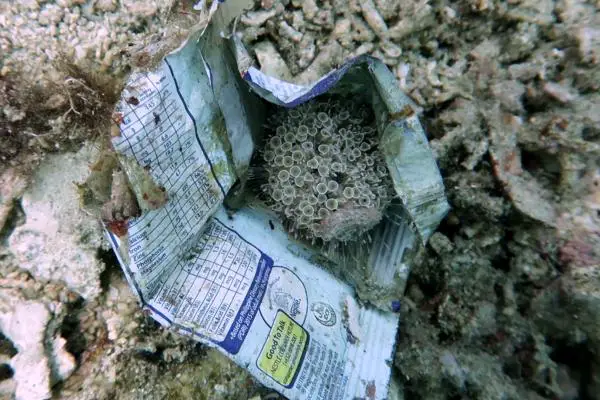
For instance, I once picked up what I thought was an empty food packaging only to find a highly venomous flower urchin (Toxopneustes pileolus) inside. That dive could have ended badly, had I not been careful.
9. Be selective
When removing marine debris, it is very easy to just take anything that doesn’t seem to belong in the ocean. Focus on removing non-biodegradable items that marine animals can easily ingest or get trapped in.
Your priority is to remove all kinds of soft and hard plastic. Examples of these are single-use plastic bags, food wrappers, product packaging, plastic bottles, bottle caps, straws, 6-pack rings, plastic utensils, feminine products, plastic diapers, cigarette butts, and many more.
Clothing or any form of textile should also be removed from the ocean. These things can cover and wrap around coral.
Fishing gear like nets, broken fish traps, and fishing lines with hooks should be removed slowly. Use your dive knife or wire cutters to remove the fishing gear in sections. If you find a fishing line, don’t tug on it as it may snag on a coral. Follow the line and wind it around an object to control it.
Items made of rubber such as tires and footwear also do not belong in the ocean.
Handle glass, tin cans, and batteries carefully when extracting them from the sea bed.
Biodegradable items like wood, coconuts, and seeds, can be left to decompose or drift back to land on their own.
10. Know when to leave things alone
While there are a lot of non-biodegradable items in the ocean that should be removed. There are instances wherein they are better to be left alone.
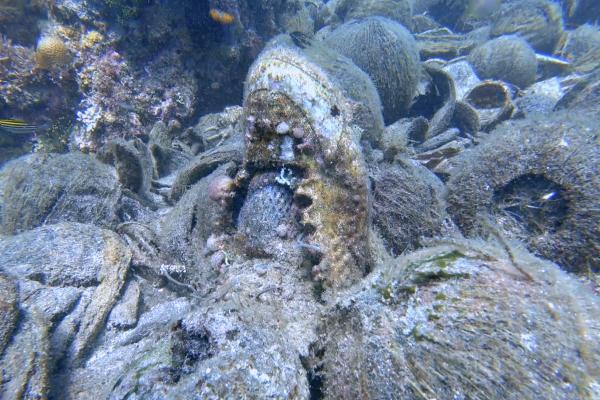
Many objects have been in the ocean for so long that they have become part of the reef already. Marine life may have grown on them and around them already. And if this is the case, it is better to leave them alone.
Some objects are also used as homes by other critters. Bottles and cans can be a hiding place for octopus, shrimps, crabs, and fish. Some animals even lay their eggs inside or around these objects and by taking them you could be killing them instead. Make it a practice to search for marine life that could be hiding in objects before you collect it as trash.
Do not attempt to remove heavy items that can be dangerous or cause injury. Containers that may contain hazardous materials should be left alone. If this is something to be concerned with, take note of the spot and ask help from experts to extract it rather than doing it yourself.
11. Use a lift bag to remove heavy objects
In the instance that there is a lot of trash in the ocean and your load becomes too heavy for you, don’t use your BCD to help lift the bag for you. Use proper tools like a lift bag. It is basically a device you fill with air and attach to a heavy item so it lifts the item to the surface.

If a lift bag is not available, I’ve seen divers use their dSMB to help bring the trash back to the surface. This is much safer than you carrying the entire load of trash.
12. Go through the trash collected and check for marine animals
As soon as you exit the water, find a place where you can empty the trash bags. Choose a spot that’s close to the ocean but also not too windy that trash will start flying everywhere. The next task is to sort through the trash you’ve collected and look for marine animals that you might have accidentally taken.
Look for octopuses, shrimps, crabs, sea slugs, and other small critters that may be hiding. Return them to the ocean as soon as you see them.
13. Do a trash audit
Another aspect of cleanup events that organizers might not include is doing a trash audit. Collecting data about the trash you’ve collected is an important aspect of a dive cleanup.
Ocean Conservancy has a Clean Swell apps and PADI Aware Foundation has Dive Against Debris to make trash audits easier. These organizations will ask you to provide information about your cleanup. You will need to submit information on where the cleanup took place, how many people were involved, and the quantity and weight of trash you collected.
The data you collect becomes part of a report that is shared with scientists, policymakers, and other stakeholders from all over the world. This report can be used to make decisions and make changes within communities when it comes to dealing with ocean plastic problems.
If you would like to be part of these bigger global studies, join events that include auditing the trash collected.
14. Properly dispose of the trash
Once you’re done going through the trash you’ve collected, remember to separate the trash into recyclables and non-recyclables. Dispose of the trash properly according to the waste management system in your local area.
Clean up after yourself and always leave a place better than when you arrived.
15. Share on social media to create awareness
Take pictures and post about your ocean conservation efforts on your Facebook, Instagram, Twitter, Tiktok accounts. Don’t be shy to use social media to advocate for the ocean.
You never know whom you might inspire. They might even want to participate in the next cleanup event.
Posting on social media creates awareness about our ocean’s plastic problem. And the more people who know about it, the better it is for our planet.
Making a difference beyond the cleanup dive.
As an avid scuba diver, I have also made it a point to make each dive a cleanup dive.
Sometimes I carry a small mesh bag with me and when I notice a dive site that’s filled with plastic, I take it out and do an impromptu cleanup.
When I see plastic floating midwater or on the sandy bottom, I grab it and tuck it in my BCD so no other marine animal will eat it. When I see a discarded fishing net on top of corals, I take out my dive knife and gently remove it so no other critters will be trapped under it.
I encourage you to do the same.
For divers who want to help save our oceans, you don’t have to wait for an underwater or beach cleanup event to do it.
Find ways in your everyday life to say no to plastic and to live more sustainably. Support organizations or companies who advocate for the ocean. Get more people to fall in love with the ocean as you have and they will want to save it too.
Did this post inspire you to be a more eco-conscious diver? Pin this for later or share to your dive buddy!
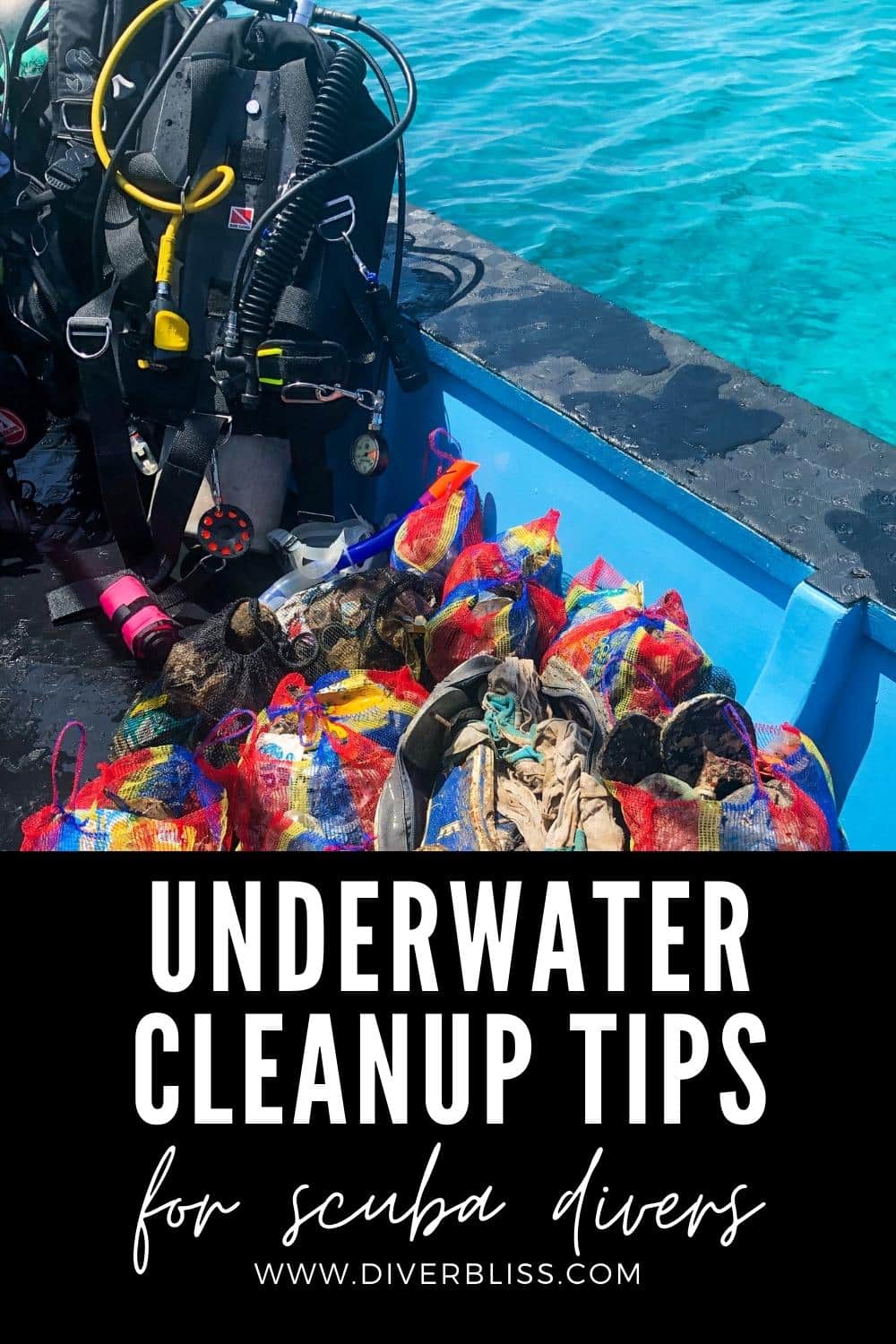
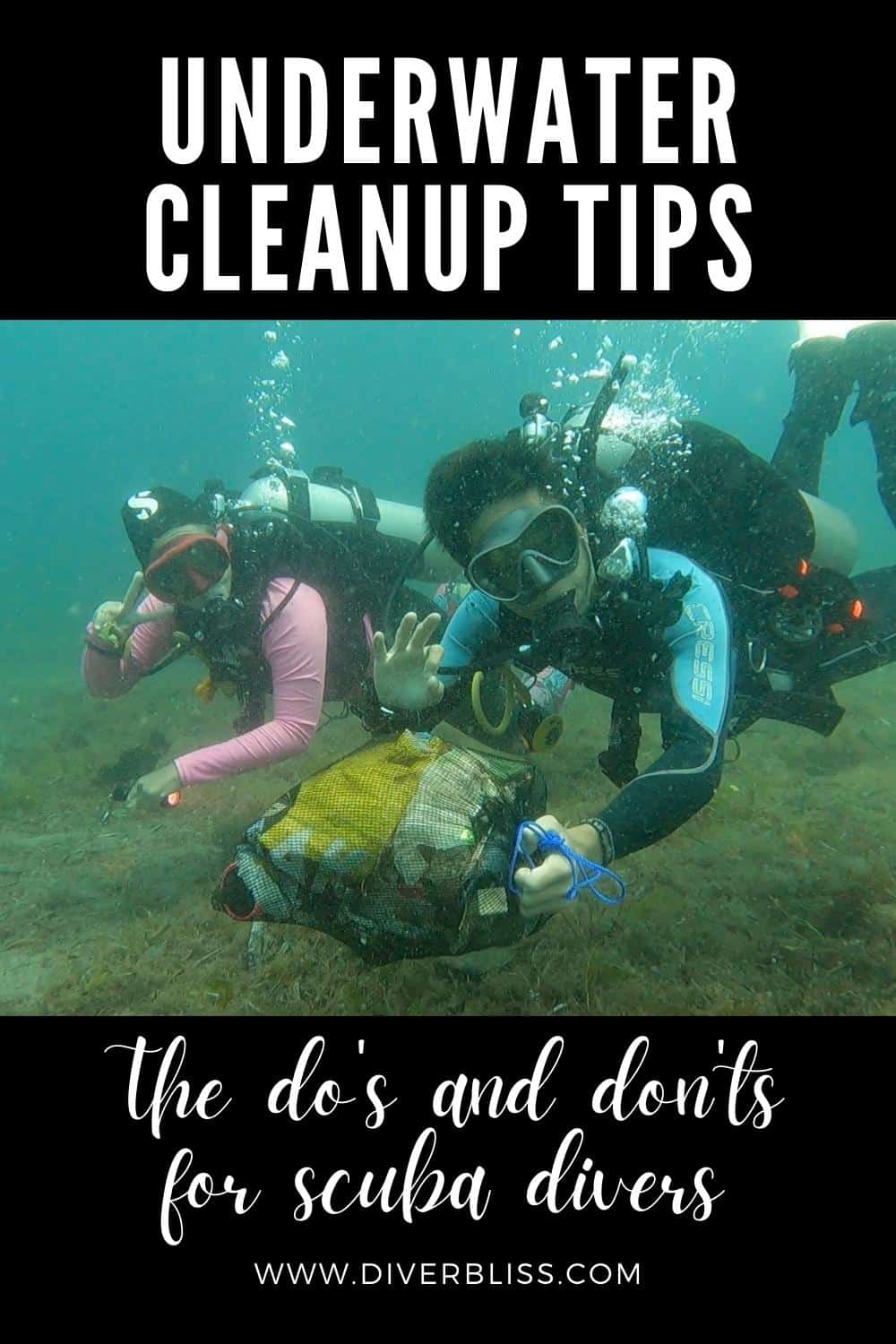
Have you participated in an underwater cleanup event before? What tips do you have for scuba divers who are joining a cleanup dive? Leave a comment below!
